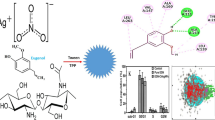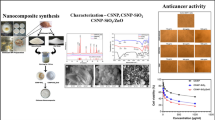Abstract
In this study, greenly synthesized hybrid chitosan silver nanoparticles were prepared and loaded with doxorubicin (Dox). The prepared silver chitosan nanoparticles (Ch-AgNPs) were characterized by transmission electron microscopy, zeta potential, size distribution measurements, UV/VIS absorption spectroscopy, and FTIR spectroscopy. The doxorubicin release profile was evaluated at different pH to investigate the efficacy of Ch-AgNPs-Dox for controlled Dox release. Additionally, the anti-cancer activity of Ch-AgNPs-Dox was assessed against breast cancer cell line in-vitro and Ehrlich tumor in-vivo. TEM analysis indicates the formation of spherical crystalline nanoparticles. Dynamic light scattering measurements indicate that the average diameter of the prepared nanoparticles is 48 ± 13 nm with zeta potential 57.5 ± 4.67 mv. Moreover, light microscopy examinations revealed a high percentage of cell death in Ch-AgNPs-Dox–treated group compared with Ch-AgNPs or free Dox. The current study provides a new approach for preparing hybrid chitosan silver nanoparticles with sustained Dox release for the purpose of cancer treatment. In this context, the promising Ch-AgNPs-Dox showed a pronounced anti-cancer activity against human breast cancer cells (in-vitro) and subcutaneous tumors (in-vivo).









Similar content being viewed by others
References
Elieh-Ali-Komi, D., & Hamblin, M. R. (2016). Chitin and chitosan: production and application of versatile biomedical nanomaterials. International Journal of Advanced Research, 4(3), 411.
Khor, E., & Lim, L. Y. (2003). Implantable applications of chitin and chitosan. Biomaterials, 24(13), 2339–2349.
Honarkar, H., & Barikani, M. (2009). Applications of biopolymers I: chitosan. Monatshefte für Chemie-Chemical Monthly, 140(12), 1403.
Pang, Y., et al. (2017). Biodegradable and biocompatible high elastic chitosan scaffold is cell-friendly both in vitro and in vivo. Oncotarget, 8(22), 35583.
Liu, F., Xiao, et al. (2001). Antibacterial action of chitosan and carboxymethylated chitosan. Journal of Applied Polymer Science, 79(7), 1324–1335.
Naskar, S., Sharma, S., & Kuotsu, K. (2019). Chitosan-based nanoparticles: an overview of biomedical applications and its preparation. Journal of Drug Delivery Science and Technology, 49, 66–81.
Suh, J.-K. F., & Matthew, H. W. T. (2000). Application of chitosan-based polysaccharide biomaterials in cartilage tissue engineering: a review. Biomaterials, 21(24), 2589–2598.
Ibrahim, H. M., Farid, O. A., Samir, A., & Mosaad, R. M. (2018). Preparation of chitosan antioxidant nanoparticles as drug delivery system for enhancing of anti-cancer drug. In Key Engineering Materials (Vol. 759, pp. 92–97). Trans Tech Publications Ltd.
Sonia, T. A., & Sharma, C. P. (2011). Chitosan and its derivatives for drug delivery perspective. In Chitosan for biomaterials I (pp. 23–53). Berlin, Heidelberg: Springer.
Muzzarelli, R. A. A. (2009). Chitins and chitosans for the repair of wounded skin, nerve, cartilage and bone. Carbohydrate Polymers, 76(2), 167–182.
Burdușel, A.-C., et al. (2018). Biomedical applications of silver nanoparticles: an up-to-date overview. Nanomaterials, 8(9), 681.
Chowdhury, N. R., et al. (2016). ‘Chocolate’ silver nanoparticles: synthesis, antibacterial activity and cytotoxicity. Journal of Colloid and Interface Science, 482, 151–158.
Faisal, N., & Kumar, K. (2017). Polymer and metal nanocomposites in biomedical applications. Biointerface Research in Applied Chemistry, 7(6), 2286–2294.
Alexander, J. W. (2009). History of the medical use of silver. Surgical Infections, 10(3), 289–292.
Rai, M. K., et al. (2012). Silver nanoparticles: the powerful nanoweapon against multidrug-resistant bacteria. Journal of Applied Microbiology, 112(5), 841–852.
Sistani, P., et al. (2014). A penicillin biosensor by using silver nanoparticles. International Journal of Electrochemical Science, 9, 6201–6212.
Khan, Y., et al. (2017). Bio-synthesized silver nanoparticles using different plant extracts as anti-cancer agent. Journal of Nanomedine and Biotherapeutic Discovery, 7(154), 2.
Thapa, R. K., et al. (2017). Silver nanoparticle-embedded graphene oxide-methotrexate for targeted cancer treatment. Colloids and Surfaces B: Biointerfaces, 153, 95–103.
Sharma, H., et al. (2015). Metal nanoparticles: a theranostic nanotool against cancer. Drug Discovery Today, 20(9), 1143–1151.
Yousefzadi, M., Rahimi, Z., & Ghafori, V. (2014). The green synthesis, characterization and antimicrobial activities of silver nanoparticles synthesized from green alga Enteromorpha flexuosa (wulfen) J. Agardh. Materials Letters, 137, 1–4.
Kotcherlakota, R., Das, S., & Patra, C. R. (2019). Therapeutic applications of green-synthesized silver nanoparticles. In Green Synthesis, Characterization and Applications of Nanoparticles (pp. 389–428). Elsevier.
Ahmed, S., et al. (2016). A review on plants extract mediated synthesis of silver nanoparticles for antimicrobial applications: a green expertise. Journal of Advanced Research, 7(1), 17–28.
Xue, B., et al. (2016). Biosynthesis of silver nanoparticles by the fungus Arthroderma fulvum and its antifungal activity against genera of Candida, Aspergillus and Fusarium. International Journal of Nanomedicine, 11, 1899.
Castro-Aceituno, V., et al. (2016). Anticancer activity of silver nanoparticles from Panax ginseng fresh leaves in human cancer cells. Biomedicine & Pharmacotherapy, 84, 158–165.
Elbialy, N., Mohamed, N., & Monem, A. S. (2013). Preparation and characterization of SiO2–Au nanoshells: in vivo study of its photo-heat conversion. Journal of Biomedical Nanotechnology, 9(2), 158–166.
Chen, Y., et al. (2011). Anticancer efficacy enhancement and attenuation of side effects of doxorubicin with titanium dioxide nanoparticles. International Journal of Nanomedicine, 6, 2321.
Zhao, N., Woodle, M. C., & Mixson, A. J. (2018). Advances in delivery systems for doxorubicin. Journal of Nanomedicine & Nanotechnology, 9(5).
Tan, S., et al. (2011). Dynamic self-assembly synthesis and controlled release as drug vehicles of porous hollow silica nanoparticles. Microporous and Mesoporous Materials, 142(2–3), 601–608.
Ramalingam, V., et al. (2018). Target delivery of doxorubicin tethered with PVP stabilized gold nanoparticles for effective treatment of lung cancer. Scientific Reports, 8(1), 3815.
Du, Y., et al. (2018). Synthesis and evaluation of doxorubicin-loaded gold nanoparticles for tumor-targeted drug delivery. Bioconjugate Chemistry, 29(2), 420–430.
Monem, A. S., Elbialy, N., & Mohamed, N. (2014). Mesoporous silica coated gold nanorods loaded doxorubicin for combined chemo–photothermal therapy. International Journal of Pharmaceutics, 470(1–2), 1–7.
Sadaf, S., & Walder, L. (2017). Doxorubicin adsorbed on carbon nanotubes: helical structure and new release trigger. Advanced Materials Interfaces, 4(19), 1700649.
Senthilkumar, P., Yaswant, G., Kavitha, S., Chandramohan, E., Kowsalya, G., Vijay, R., Sudhagar, B., & Ranjith Santhosh Kumar, D. S. (2019). Preparation and characterization of hybrid chitosan-silver nanoparticles (Chi-Ag NPs); a potential antibacterial agent. International Journal of Biological Macromolecules, 141, 290–297.
Bose, A., & Wong, T. W. (2018). Oral colon cancer targeting by chitosan nanocomposites. In Applications of Nanocomposite Materials in Drug Delivery (pp. 409–429). Woodhead Publishing.
Mishra, D. K., et al. (2018). Nanocomposite for cancer targeted drug delivery. In Applications of Nanocomposite Materials in Drug Delivery (pp. 323–337). Woodhead Publishing.
Rasoulzadehzali, M., & Namazi, H. (2018). Facile preparation of antibacterial chitosan/graphene oxide-Ag bio-nanocomposite hydrogel beads for controlled release of doxorubicin. International Journal of Biological Macromolecules, 116, 54–63.
Abaza, A., Hegazy, E. A., Mahmoud, G. A., & Elsheikh, B. (2018). Characterization and antitumor activity of chitosan/poly (vinyl alcohol) blend doped with gold and silver nanoparticles in treatment of prostatic cancer model. Journal of Pharmacy and Pharmacology, 6, 659–673.
Qian, C., et al. (2016). Light-activated hypoxia-responsive nanocarriers for enhanced anticancer therapy. Advanced Materials, 28(17), 3313–3320.
Lu, Y., et al. (2015). Transformable liquid-metal nanomedicine. Nature Communications, 6, 10066.
Singh, H., Juan, D., & Yi, T.-H. (2017). Green and rapid synthesis of silver nanoparticles using Borago officinalis leaf extract: anticancer and antibacterial activities. Artificial Cells, Nanomedicine, and Biotechnology, 45(7), 1310–1316.
Singh, P., et al. (2018). In vitro anti-inflammatory activity of spherical silver nanoparticles and monodisperse hexagonal gold nanoparticles by fruit extract of Prunus serrulata: a green synthetic approach. Artificial Cells, Nanomedicine, and Biotechnology, 46(8), 2022–2032.
Hajji, S., Khedir, S. B., Hamza-Mnif, I., Hamdi, M., Jedidi, I., Kallel, R., Boufi, S., & Nasri, M. (2019). Biomedical potential of chitosan-silver nanoparticles with special reference to antioxidant, antibacterial, hemolytic and in vivo cutaneous wound healing effects. Biochimica et Biophysica Acta (BBA) - General Subjects, 1863(1), 241–254.
Laghrib, F., Ajermoun, N., Bakasse, M., Lahrich, S., & El Mhammedi, M. A. (2019). Synthesis of silver nanoparticles assisted by chitosan and its application to catalyze the reduction of 4-nitroaniline. International Journal of Biological Macromolecules, 135, 752–759.
Victor, S. P., Paul, W., Jayabalan, M., & Sharma, C. P. (2014). Supramolecular hydroxyapatite complexes as theranostic near-infrared luminescent drug carriers. CrystEngComm, 16(38), 9033–9042.
Nguyen, H. N., Hoang, T. M. N., Mai, T. T. T., Nguyen, T. Q. T., Do, H. D., Pham, T. H., Nguyen, T. L., & Ha, P. T. (2015). Enhanced cellular uptake and cytotoxicity of folate decorated doxorubicin loaded PLA-TPGS nanoparticles. Advances in Natural Sciences: Nanoscience and Nanotechnology, 6(2), 025005.
Zare, M., Samani, S. M., & Sobhani, Z. (2018). Enhanced intestinal permeation of doxorubicin using chitosan nanoparticles. Advanced Pharmaceutical Bulletin, 8(3), 411.
Cinteza, L., et al. (2018). Chitosan-stabilized Ag nanoparticles with superior biocompatibility and their synergistic antibacterial effect in mixtures with essential oils. Nanomaterials, 8(10), 826.
Seifirad, S., et al. (2016). Design and characterization of mesalamine loaded nanoparticles for controlled delivery system. Nanomedicine Research Journal, 1(2), 97–106.
Kim, C. G., et al. (2018). Caspase-3/MAPK pathways as main regulators of the apoptotic effect of the phyto-mediated synthesized silver nanoparticle from dried stem of Eleutherococcus senticosus in human cancer cells. Biomedicine & Pharmacotherapy, 99, 128–133.
Osman, M. E., Eid, M. M., Khattab, O. H., El-Hallouty, S., El-Manawaty, M., & Mahmoud, A. D. (2015). In vitro cytotoxicity of biosynthesized Ag/CS NP against MCF7, PC3 and A549 cancer cell lines. International Journal of PharmTech Research, 8, 1011–1017.
Kalyanaraman, B. J. S. S. E. S., et al. (2002). Doxorubicin-induced apoptosis: implications in cardiotoxicity. Molecular and Cellular Biochemistry, 234(1), 119–124.
Patel, M. P., Patel, R. R., & Patel, J. K. (2010). Chitosan mediated targeted drug delivery system: a review. Journal of Pharmacy & Pharmaceutical Sciences, 13(4), 536–557.
Acknowledgments
The author is thankful to Cairo University for offering chemical products and also for providing all the laboratory facilities for this study.
Funding
None
Author information
Authors and Affiliations
Corresponding author
Ethics declarations
Conflict of interest
The author declares that there is no conflict of interest.
Research involving Animal
The study protocol met the approval conditions of the institutional animal care and use committee (IACUC) with an approval number (CUIF1820), Cairo University.
Informed Consent
None
Additional information
Publisher’s Note
Springer Nature remains neutral with regard to jurisdictional claims in published maps and institutional affiliations.
Rights and permissions
About this article
Cite this article
Mohamed, N. Synthesis of Hybrid Chitosan Silver Nanoparticles Loaded with Doxorubicin with Promising Anti-cancer Activity. BioNanoSci. 10, 758–765 (2020). https://doi.org/10.1007/s12668-020-00760-y
Published:
Issue Date:
DOI: https://doi.org/10.1007/s12668-020-00760-y




